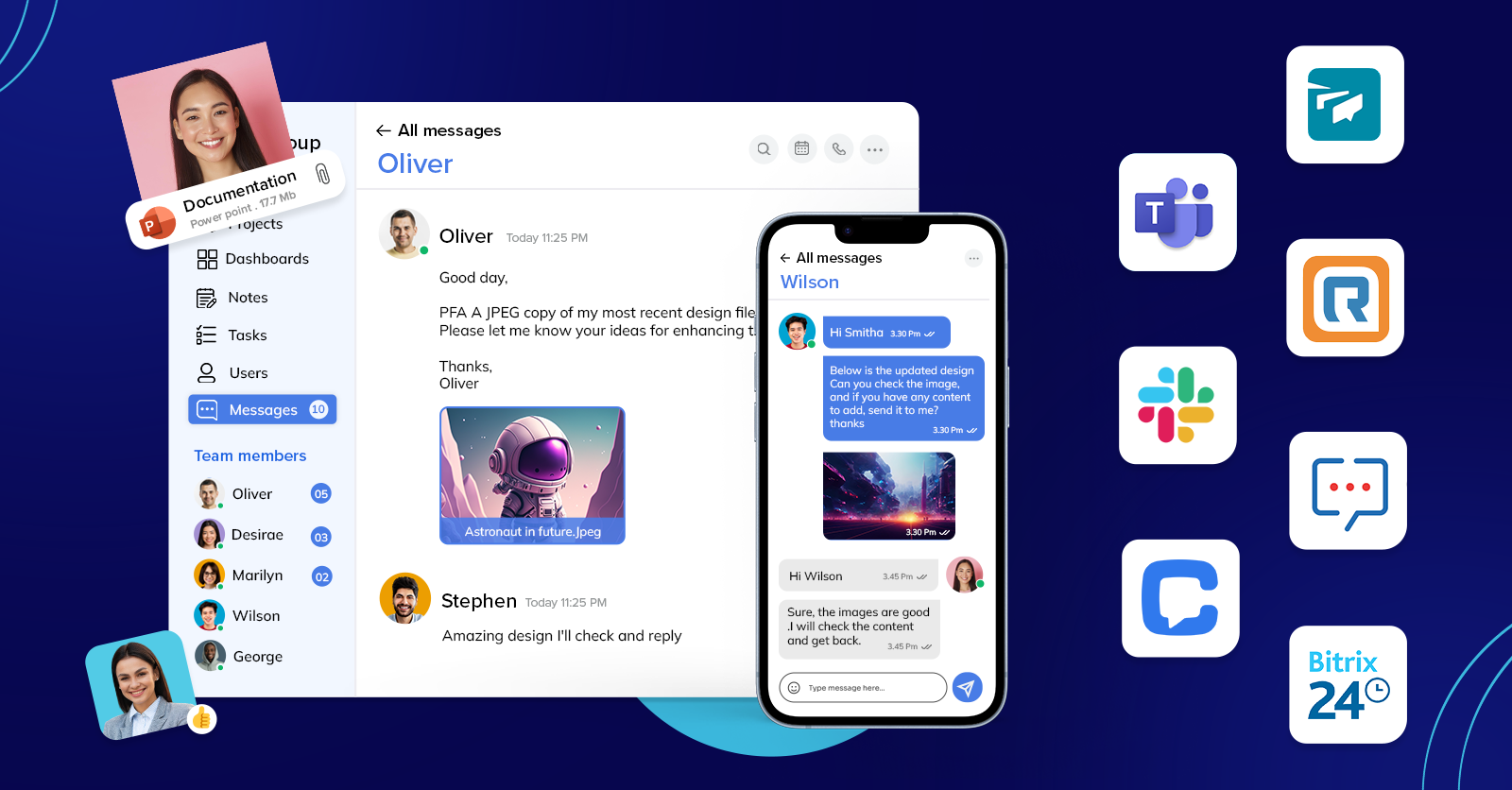10 Best Tools for Managing a Remote Team Productivity

Remote work has changed the name of the game. It is the new norm for many organizations big and small, who are looking to ride the wave of the coronavirus pandemic’s impact towards a transformed way of working. In India, 88% of the workforce has shifted to a ‘work from home’ setup and 69% of them believe that they’ve seen their productivity increased after that shift.
However, if you were to ask the burning question of how to manage a remote team, the uncomplicated answer is that managing a remote team is not a cakewalk. A centralized office allows employees to interact frequently and helps organizations keep an eye on things, figuratively. When the team is spread out, the story becomes different — and it becomes a Herculean effort to ensure those same levels of efficiency and productivity when there are no physical interactions.
As a result, the tools that an organization chooses to manage their remote teams become the linchpin to creating a dynamic and organized work environment that still retains a distinctive sense of culture. This is one of the most important best practices for managing remote teams.
How Tools for Managing Remote Teams are Crucial?
The tool you pick to manage a remote team can accentuate or undermine their productivity with its features and ease of use. Additionally, different tools have different capabilities. Retrospective tools for remote teams, for example, focus specifically on running agile retrospectives and spurring collaboration. It helps to evaluate which best suits the type of industry your organization falls under, the kind of work you do and the demands you may have on remote team management tools of your choice.
Table of Contents
10 Best Tools for Remote Teams to Consider Adopting
The top 10 best Remote team tools in 2025 reviews are Trello, Basecamp, Workstatus, Slack, Dropbox, Apploye, WebWork Time Tracker, Jira, Asana & ProofHub.
1. Trello

Trello is a familiar name in the world of remote working, not least because it is one of the more popular remote working tools out there. It is a great tool for organizing tasks and priorities in a visually appealing manner, through the use of cue cards, workflows, rule-based triggers, commands and more. The visibility that Trello offers on individual tasks and overarching projects is useful in helping remote teams get the lay of the land, see what everyone is working on, and prioritize tasks according to urgency.
2. Basecamp

Basecamp is a handy project management system that functions on quite a number of macro and micro levels. Basecamp is specially built to handle remote team management because it helps to organize all essential information on one platform without forcing employees to check emails, messages, recordings, documents and other assets when they need something urgently. It keeps everyone aware of pending and completed tasks, discussions, schedules, milestones, and opportunities for collaboration.
The software is accessible on the web and on iOS and Android devices so it promises accessibility and productivity on the go. A Basecamp review explores how its all-in-one approach helps teams manage projects more effectively while fostering collaboration and improving overall efficiency.
3. Workstatus

Workstatus is one of the trendsetters in the market that comes up when we mention leading time tracking & productivity management tools. It caters to different teams and industries, irrespective of the size. With AI-powered intuitive features, it has been a prominent choice for automating workflows, tracking attendance, refining productivity and a lot more. With customization and budget-friendly pricing being the prime highlights of this time tracking tool, businesses are inclined toward Workstatus.
4. Slack

Slack is one of the leading communication tools for remote teams, as it presents itself as a more informal but still work-oriented remote meeting platform. The multiple channels and environments allow for targeted discussions and general water-cooler conversations. One-to-one and group chats create break-out rooms where individual teams can discuss projects. The calling card of Slack is that it negates the need for multiple emails, and also allows employees ot keep their personal communication platforms (such as WhatsApp and Telegram) free of work-related conversations. You can set up additional plugins to conduct polls, create reminders and track employee availability, among others.
5. Dropbox

Dropbox sorts out organization-level storage needs in an instant. Emails and other platforms don’t allow for easy file-sharing, especially when said files are bulky or numerous. Dropbox ensures all team members have access to the necessary files and even doubles up as a collaboration platform. The platform also becomes a handy drop-off point for files from external consultants and freelancers, to ensure that all information pertaining to an organization is accessible to all, or to a select few. The opposite is also true — you can share files with those outside the organization and deliver comments and suggestions easily through Dropbox.
6. Apploye

Apploye is one of the most popular remote team time tracking software for teams of any size. It helps teams and individuals track their time and projects for productive day to day operation.
And ensures your team is always on check in terms of any task and deadlines. Apploye’s long list of features include time tracking, app tracking, live screenshots, productivity tracker, task management, billing, invoicing, etc.
Which makes it perfectly balanced for remote teams, inhouse teams and even for freelancers. Individuals or teams can manage tasks, track time, prepare reports & even send invoices accordingly just using this app.
7. WebWork Time Tracker

WebWork is a time-tracking tool that makes remote employee monitoring easy. It offers a collection of features that help business owners and managers get the most from their teams. This includes employee activity monitoring, time tracking, app and website usage monitoring, and more. For organizations managing a dispersed workforce, it’s also important to have efficient strategies in place to procure IT hardware, ensuring remote employees are equipped with the necessary tools to stay productive.
8. Jira

Jira is built for remote software teams and enables collaboration and seamless planning. Users can plan sprints, distribute tasks and prioritize projects as a team with unhindered visibility. Since it’s software-oriented, it is also one of the handiest tools for remote teams who need to put out and track software releases, manage knowledge and resources, and monitor build status for continuous integration and deployment.
9. Asana

Asana helps to organize team files, plans, tasks and schedules onto one shared space that is visible to everyone in that team. It helps in micro-managing individual and collective tasks that contribute to a larger goal and allows teams to create related timelines to ensure seamless project delivery. What makes it one of the most sought out tools for managing remote teams is that it enables automation of menial tasks which help to simplify workflows and reduce errors to a bare minimum. A variety of views — calendars, lists, priorities, Kanban boards — helps individual team members organize their virtual workspace the way they work best, while still keeping things functional and high on visibility.
10. ProofHub

ProofHub is a comprehensive remote work tool that brings project management and team collaboration together into a single platform. It lets you assign tasks, collaborate in real-time, and share files, eliminating the need for multiple tools. Its seamless interface ensures everyone stays on the same page. ProofHub’s all-in-one approach reduces complexity, so you can focus on your work instead of managing multiple tools, making it a must-have for remote teams aiming for productivity. The best part is its fixed flat pricing structure, which means you can add as many users as you want without incurring any additional expenses.
11. Microsoft Teams

Microsoft Teams is the go-to hub for teamwork, communication and collaboration between members of a remote team. It packs quite a few features that go beyond niches such as project management and communication to make it one of the more all-rounder remote team-building tools. It has chats and threaded conversations, video and audio calling and content distribution and collaboration powered by the suite of Microsoft 365 applications that most companies are already familiar with and well-versed in.
12. MirrorFly

MirrorFly is one of the most efficient remote collaboration platforms in the market that has the potential to connect thousands of remote teams across all your offshore offices. The team collaboration platform is a customizable one, added with built-in various communication mediums such as real-time group chat platform, Video call, and voice call. MirrorFly plays a hub for overall team management tools where you get the opportunity to host meetings, webinars, client virtual interaction & more to do. The enterprise-grade collaboration tools precisely fit right from a large enterprise organization to medium-sized organizations.
13. Google Meet

Google Meet is a very popular communication tool to keep in touch with individuals and groups of people. It replaced Google Hangouts along with Google Chat and connects well to Gmail, which is frequently used as the email service provider of choice by many companies big or small. The enterprise-oriented communication platform makes secure video conversations accessible to teams and enables essential additions such as screen sharing and whiteboarding. Meet caters more to the communication aspect of remote teams than anything else, but it is still a handy addition to any such team’s toolkit.
14. Skype

Skype is one of most loved remote team management tools available in the market for free and premium plans for international calling. Their UI and UX are quite simple but though effective to use on-the-go. The software comes with Skype for business activities to host meetings, interviews, client interactions, and more across any device end-to-end synchronization. Their solution is a package of bonus for the teams and organizations that are operated remotely. Skype for business comes with many effectual features such as Live call recording, screen sharing, Group video conferencing and more.
15. Time Champ

Time Champ is an excellent tool for remote teams, making it easier to boost productivity and teamwork across different locations. Its user-friendly interface and strong features help team members manage their schedules efficiently, plan meetings across time zones without hassle, and keep track of tasks clearly and accurately. Setting reminders helps everyone stay organized and reduces the chances of missing deadlines or conflicting schedules. Time Champ promotes openness and responsibility by updating project timelines and individual progress in real-time, which improves communication and decision-making among team members, no matter where they are. For remote teams looking to work more efficiently and smoothly, Time Champ is incredibly helpful for handling complex scheduling issues and keeping workflows coordinated.
15. Time Card Calculator

Every business faces difficulty in managing timesheets or attendance records of employees, especially when they are working remotely. However, a free time card calculator can help manage these tasks easily and quickly. It helps to calculate the weekly working hours of employees based on their clock-in and clock-out times. Additionally, the administration can also use it to calculate the justified payroll based on the wage rate and exact working hours calculated. Even if an employee works more than the regular shift hours, entering details in the tool can also give overtime pay calculations, which is another plus.
Conclusion
When it comes to deciding on how to manage your team remotely, it all boils down to the tools you employ and the people that make up the team. If you’re looking to build your first-ever remote team to manage, CONTUS DigitalTeams is your one-stop-shop for creating a high-agency, skill-heavy team of diverse people to take your projects from 0 to 100.



